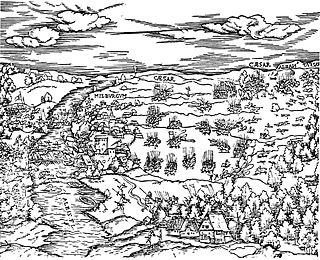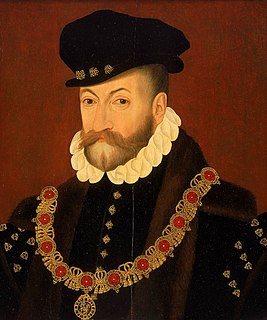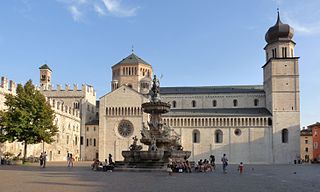Related Research Articles

The Council of Trent, held between 1545 and 1563 in Trent, was the 19th ecumenical council of the Catholic Church. Prompted by the Protestant Reformation, it has been described as the embodiment of the Counter-Reformation.

Trento is a city on the Adige River in Trentino-Alto Adige/Südtirol in Italy. It is the capital of the autonomous province of Trento. In the 16th century, the city was the location of the Council of Trent. Formerly part of Austria and Austria-Hungary, it was annexed by Italy in 1919. With almost 120,000 inhabitants, Trento is the third largest city in the Alps and second largest in the Tyrol.

The Italian Wars, often referred to as the Great Wars of Italy and sometimes as the Habsburg–Valois Wars, were a long series of wars fought between 1494 and 1559 in Italy during the Renaissance. The Italian peninsula, economically advanced but politically divided among several states, became the main battleground for European supremacy. The conflicts involved the major powers of Italy and Europe, in a series of events that followed the end of the 40-year long Peace of Lodi agreed in 1454 with the formation of the Italic League.

The Battle of Mühlberg took place near Mühlberg in the Electorate of Saxony in 1547, during the Schmalkaldic War. The Catholic princes of the Holy Roman Empire led by the Holy Roman Emperor Charles V decisively defeated the Lutheran Schmalkaldic League of Protestant princes under the command of Elector John Frederick I of Saxony and Landgrave Philip I of Hesse.

Giovanni Battista Moroni was an Italian painter of the Late Renaissance period. He also is called Giambattista Moroni. Best known for his elegantly realistic portraits of the local nobility and clergy, he is considered one of the great portrait painters of sixteenth century Italy.

The Schmalkaldic War refers to the short period of violence from 1546 until 1547 between the forces of Emperor Charles V of the Holy Roman Empire, commanded by the Duke of Alba and the Duke of Saxony, and the Lutheran Schmalkaldic League within the domains of the Holy Roman Empire.

Edward Fiennes, or Clinton, 1st Earl of Lincoln KG was an English landowner, peer, and Lord High Admiral. He rendered valuable service to four of the Tudor monarchs.

Cristoforo Madruzzo was an Italian Roman Catholic cardinal and statesman. His brother Eriprando was a mercenary captain who fought in the Italian Wars.

The Battle of Ravenna, fought on 11 April 1512, was a major battle of the War of the League of Cambrai. It pitted forces of the Holy League against France and their Ferrarese allies. Although the French and Ferrarese decimated the Papal-Spanish forces, their extraordinary triumph was overshadowed by the loss of their brilliant young general Gaston of Foix. The victory therefore did not help them secure northern Italy. The French withdrew entirely from Italy in the summer of 1512, as Swiss mercenaries hired by Pope Julius II and Imperial troops under Emperor Maximilian I arrived in Lombardy. The Sforza was restored to power in Milan.

The Battle of Bicocca or La Bicocca was fought on 27 April 1522, during the Italian War of 1521–26. A combined French and Venetian force under Odet of Foix, Viscount of Lautrec, was decisively defeated by an Imperial–Spanish and Papal army under the overall command of Prospero Colonna. Lautrec then withdrew from Lombardy, leaving the Duchy of Milan in Imperial hands.

The Battle of Ceresole took place on 11 April 1544, during the Italian War of 1542–46, outside the village of Ceresole d'Alba in the Piedmont region of Italy. A French army, commanded by François de Bourbon, Count of Enghien, defeated the combined forces of the Holy Roman Empire and Spain, commanded by Alfonso d'Avalos d'Aquino, Marquis del Vasto. Despite having inflicted substantial casualties on the Imperial troops, the French subsequently failed to exploit their victory by taking Milan.

The Italian War of 1551–1559, sometimes known as the Habsburg–Valois War and the Last Italian War, began when Henry II of France declared war against Holy Roman Emperor Charles V with the intent of recapturing Italy and ensuring French, rather than Habsburg, domination of European affairs. Historians have emphasized the importance of gunpowder technology, new styles of fortification to resist cannon fire, and the increased professionalization of the soldiers.

The Italian War of 1542–1546 was a conflict late in the Italian Wars, pitting Francis I of France and Suleiman I of the Ottoman Empire against the Holy Roman Emperor Charles V and Henry VIII of England. The course of the war saw extensive fighting in Italy, France, and the Low Countries, as well as attempted invasions of Spain and England. The conflict was inconclusive and ruinously expensive for the major participants.

The Prince-Bishopric of Trent, was an ecclesiastical principality roughly corresponding to the present-day Northern Italian autonomous province of Trentino. It was created in 1027 and existed until 1802, when it was secularised and absorbed into the County of Tyrol held by the House of Habsburg. Trent was a Hochstift, an Imperial State under the authority of a prince-bishop at Trento.

Alfonso d'Avalos d'Aquino, VI marquis of Pescara and II of Vasto, was an Italian condottiero of Spanish origins, renowned for his service in favor of Charles V, Holy Roman Emperor and King of Spain.

Otto Truchsess von Waldburg was Prince-Bishop of Augsburg from 1543 until his death and a Cardinal of the Catholic Church.

Ludovico Madruzzo (1532–1600) was an Italian Roman Catholic cardinal and statesman, the Imperial crown-cardinal and Prince-Bishop of the Bishopric of Trento.

Carlo Gaudenzio Madruzzo was an Italian Roman Catholic cardinal and statesman.

The Italian Catholic Archdiocese of Trento, in the Triveneto, is a Latin Catholic Metropolitan Archdiocese named after its see in Alpine Italy, Trento, in Trentino-Alto Adige region. On 31 May 1027, the Emperor Conrad II granted the bishops of Trent the County of Trent, making the bishops part of the German Empire, and thereby beginning the history of the prince-bishopric. As a prince-bishopric, the bishop's temporal possessions also constituted a state of the Holy Roman Empire. In 1803, the prince-bishopric was secularized and assigned to the Kingdom of Bavaria, but in 1810 Napoleon claimed it for his kingdom of Italy. On Napoleon's fall, the Tyrol became part of the Austrian Empire.
References
- Madruzzo genealogy (in Italian)
- Oman, Charles (1937). A History of the Art of War in the Sixteenth Century. London: Methuen & Co.
| | This biographical article related to the Italian military is a stub. You can help Wikipedia by expanding it. |